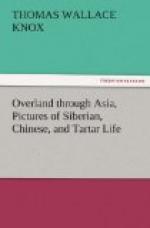The Kiachta teas are far superior to those from Canton and Shanghae. They come from the best districts of China and are picked and cured with great care. There is a popular notion, which the Russians encourage, that a sea voyage injures tea, and this is cited as the reason for the character of the herb brought to England and America. I think the notion incorrect, and believe that we get no first class teas in America because none are sent there. I bought a small package of the best tea at Kiachta and brought it to New York. When I opened it I could not perceive it had changed at all in flavor. I have not been able to find its like in American tea stores.
Previous to 1850 all trade at Kiachta was in barter, tea being exchanged for Russian goods. The Russian government prohibited the export of gold and silver money, and various subterfuges were adopted to evade the law. Candlesticks, knives, idols, and other articles were made of pure gold and sold by weight. Of course the goods were “of Russian manufacture.”
Before 1860 the importation of tea at Kiachta was about one million chests annually, and all of good quality and not including brick tea. The “brick tea” of Mongolia and Northern China is made from stalks, large leaves, and refuse matter generally. This is moistened with sheep’s or bullock’s blood and pressed into brick-shaped cakes. When dried it is ready for transportation, and largely used by the Mongols, Bouriats, Tartars, and the Siberian peasantry. In some parts of Chinese Tartary it is the principal circulating medium of the people. Large quantities are brought into Siberia, but “brick-tea” never enters into the computation of Kiachta trade.
[Illustration: LEGAL TENDER.]
Since 1860 the quantity of fine teas purchased at Kiachta has greatly fallen off. The importation of brick-tea is undiminished, and some authorities say it has increased.
None of the merchants speak any language but Russian, and most of them are firmly fixed at Kiachta. They make now and then journeys to Irkutsk, and regard such a feat about as a countryman on the Penobscot would regard a visit to Boston. The few who have been to Moscow and St. Petersburg have a reputation somewhat analogous to that of Marco Polo or John Ledyard. Walking is rarely practiced, and the numbers of smart turnouts, compared to the population, is pretty large. There is no theatre, concert-room, or newspaper office at Kiachta, and the citizens rely upon cards, wine, and gossip for amusement. They play much and win or lose large sums with perfect nonchalance. Visitors are rare, and the advent of a stranger of ordinary consequence is a great sensation.
Kiachta and Maimaichin stand on the edge of a Mongolian steppe seven or eight miles wide. Very little snow falls there and that little does not long remain. Wheeled carriages are in use the entire year. The elevation is about twenty-five hundred feet above sea level.




